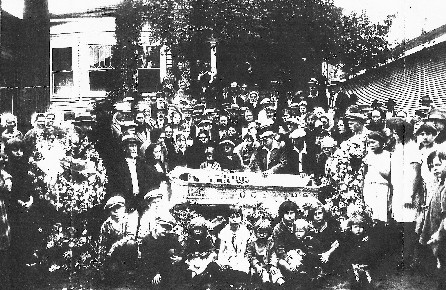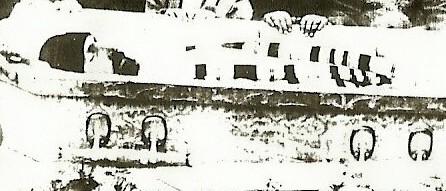6. The Subbotniki in Los Angeles
With their common heritage, it was to be expected that the Subbotniki would settle among the Molokans in Russian-town. One Subbotnik man opened a store there that, because of a common kosher practice, served both communities.A Subbotnik church was established in the Flats district of Los Angeles near the corner of First and Gless Streets. The church was a small building, but it could accommodate the two to three hundred person congregation. Kitchen facilities were located in the rear. In back of the church, there was a large fenced yard where samovars could be lit to provide hot water for chai (tea). Later on, the Subbotniks held their meetings at 611 Breed Street in Los Angeles. This is near the historic Talmud Torah Temple that is also known as the Breed Street Shul.
Relations
with the Molokans and the Jews
However, with their basic religious differences, it
is not surprising that some of the conflicts between the two sects
that
were evident in Russia, such as the consumption of wine, continued
in
America. The Subbotniks were also more prone to more quickly
abandon
the ways of the “old country” and assimilate with Americans. This
was
counter to the goals of the Molokans who were determined to
preserve
traditional values in their community. Many Molokans felt that the
presence of the Subbotniki in their neighborhood was a bad
influence on
their young people with whom they were struggling to maintain the
Molokan way of life in Flats. The Subbotniks associated to some degree with the Jews living nearby but maintained a separate identity. Some of the common elements were the burning of candles and consumption of matzos on certain religious holy days. Jewish calendars could also be found in some of the homes. The Subbotniki enjoyed convenient access to the Jewish shopping area in Boyle Heights. There they could purchase kosher foods and other items necessary to practice their religion. This included baked goods such as fresh rye bread from the original Cantor Brothers Bakery and Restaurant on Brooklyn Avenue [renamed Caesar Chavez Avenue in the 1980’s.]
Albert Parry commented on what he observed about the relationship between the Jews and the Subbotniki living in Los Angeles in the Jewish Tribune article previously cited:
In Los Angeles they find
themselves
viewed with suspicion by the great
body of the Jews there, because they cannot read Hebrew prayers,
bibles, and so on. They read and pray in Russian, they can only
look at
the Hebrew text. The other Jews look down on them, fear to give
their
daughters in marriage to them, doubt their Judaism, say they are
half-goyim(1),
as Edomite converts in Josephus' account were half-goyim
to many Jews of the time. Since they are generally poor, the
wealthier
Jews also fear that their daughter may fall into the sweatshop
or
factory, should they marry into Subbotniki families. So
Subbotniki sons
are marrying equally Americanized Molokani girls, or Armenians,
or
Mexicans. The result will be the complete Americanization of the
new
generation.
The Molokans also did not look favorably about intermarriages. Molokan and Subbotniki youth growing up in Russian-town during the “Roaring Twenties” were greatly influenced by the “open” urban environment of Los Angeles. The two groups intermingled in the public schools, organized sports teams at Pecan Park and at other programs sponsored by local social services organizations. The “mixed” marriages” that were inevitable were not condoned by the parents on either side. As a consequence, the couples had to elope to places like Yuma, Arizona where civil ceremonies were easily available. Occasionally Subbotniki services and receptions at the homes of relatives followed these weddings. The newlyweds usually lived with the Subbotniki parents until they could afford a place of their own. It could take years for the Molokan parents to fully accept the marriage, but differences were usually put aside when the grandchildren arrived. In later years, some of these offspring themselves married back into the Molokan Church and are active members today.
End of the Los Angeles Subbotniki Congregation
Members of the Subbotniki church were never numerous in Russia or in Los Angeles. With the isolation pressures from both the Molokans and the Jewish communities, the church was not successful in sustaining itself within the pressures of the growing city. In the 1950’s, as part of an urban redevelopment project, the City of Los Angeles condemned the original church property in order to build a community swimming pool — part of the expansion of the Pecan Park playground. About the same time, the homes of many of the sect’s members living nearby were cleared by the city to build a low-income housing project. This resulted in the dispersion of the Subbotniki to other parts of Los Angeles County. Some of the older Subbotnik families moved to houses in East Los Angeles near the Molokan “Big Church” on Lorena Street. Later on, Subbotnik widows found some comfort in their later years by living among their friends and relatives from the old country.The loss of its original meeting house, the dispersion of the members of the congregation and the death of key church elders led to the demise of the Subbotniki Church in Los Angeles [located at 611 S. Breed Street, 2 blocks from Hollenbeck Park]. The Subbotniki congregation held its last meeting on March 12, 1971 and was officially dissolved by its trustees two days later. As a symbol of unity, love and friendship with the Molokan community, the trustees visited the Board of Directors Meeting of the United Molokan Christian Association (UMCA) on March 8 to announce their intentions. They also presented the UMCA with the funds remaining in the Subbotniki treasury, recorded in this this photo. [See: In 1971 Subbotniki Dissolve, Gift $800 to UMCA. Also, Alex Thomas shown accepting the check is now director of the Molokan Cemetery on Slauson Avenue, City of Commerce, where some Subbotniki are buried.]
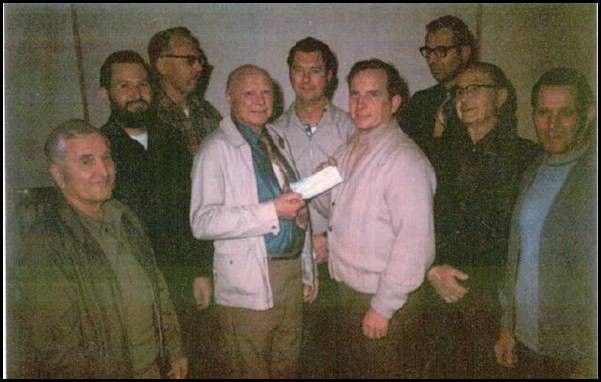
| Photo 6a. Los Angeles Subbotnik trustees present UMCA Board of Directors with treasury fund remaining after dissolving congregation in 1971. Left to right: Morris Haproff, Harry J. Shubin, Paul Zolnekoff, Alex Tolmas, Morris Shisckoff, Esai Andrews, William J. Tholmas, Mike Urkoff, Andy Valov. |
Subbotniki Funerals in Los Angeles
As was the practice among the early Molokans living in Los Angeles, the Subbotniki prepared the bodies of the deceased for viewing, prayer services and all-night vigils typically in the home of the deceased.In order to follow the prescribed ways of disposing of their dead, Subbotniki burials took place at the Home of Peace Memorial Park (2) on Whittier Boulevard adjacent to the Long Beach Freeway. Plots for many of the original Subbotniki immigrants can be found in the grassy area along the fence east of the chapel and opposite the ramp to the Long Beach Freeway. Many of the Subbotniki headstones are adorned with the Star of David or with a menorah. Some contain Hebrew writings. Once the original Subbotniki section was filled, a newer Subbotniki section was selected at the southwest corner of the main road next to the Sephardic section. Since this site is in what is considered an Orthodox Jewish section of the cemetery, the occupied graves have raised cement covers.
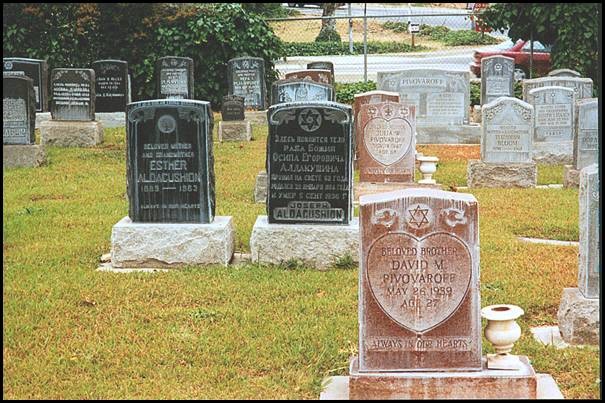
Photo of original Subbotniki burial area in the Home of Peace Memorial Park.
After the closing of the Subbotniki church in Los Angeles, funerals for some of its former members continued to be arranged through the Malinow and Silverman mortuary located at 818 West Venice Boulevard just north of the University of Southern California. Over the years, this mortuary provided thoughtful assistance to the families of deceased Subbotniki even though not all were familiar with the Jewish burial traditions of their loved ones.
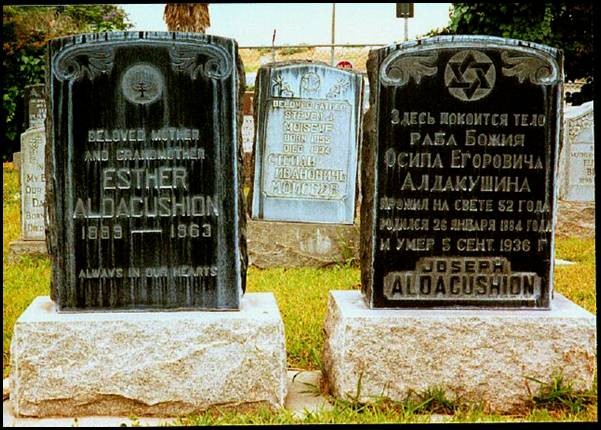
Close-up of grave stones of Esther Vasilievna (Pivovaroff) and her husband Joseph
Yegorovich Aldacushion with that of Stephan Ivanovich Moiseve in the background.
(Click on image above to zoom-in on Moiseve gravestone - Note 5-pointed Star of Bethelem rather than a 6-pointed Star of David)
Final services were conducted in the chapel at the Home of Peace Memorial Park with internment in family plots purchased long ago. Jewish rabbis were asked to officiate since Subbotniki elders were no longer available. The mortuary has now relocated to West Los Angeles, closer to the main Jewish community while the remnants of the Subbotniki moved to the eastern suburbs.
- "Goyim" is the plural of the Yiddish word Goy meaning a non-Jew or a gentile and was often used contemptuously.
- See: 115
Subbotniki
known to be buried at Home of Peace Memorial Park which includes a listing of Subbotniks buried there with links to photos of individual gravestones.
Back to Subbotniki.net
